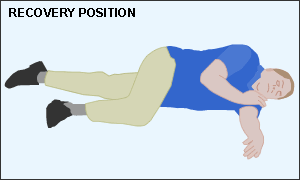This salt alternative could help reduce blood pressure. So why are so few people usingit?
Signs of a stroke include:
- weakness, paralysis (inability to move) or numbness of the face or limbs, particularly on one side of the body;
- vision suddenly becoming blurred or decreased, especially in one eye;
- difficulty talking or understanding speech;
- sudden difficulty swallowing;
- an unexplained fall, dizziness or loss of balance — someone suffering from stroke may resemble a drunk person;
- sudden severe headache or a new type of headache with no known cause; and
- drowsiness, confusion or loss of consciousness.
| What to do when someone has a stroke |
|---|
| If you suspect that you are having a stroke or that someone else is having a stroke, dial 000 for an ambulance immediately. The sooner a stroke is treated in hospital, the more likely the person is to recover. Time delays can increase the damage to the brain. |
Follow the DRSABCD Action Plan
St John Ambulance Australia recommends you follow the ‘DRSABCD Action Plan’ in every emergency. It helps you determine whether someone has a life-threatening condition and what first aid is needed.
D — check for DANGER
- To you.
- To others.
- To the affected person.
R — check RESPONSE
Ask the person their name. If someone has had a stroke, they may not be able to talk, so grasp both their hands and ask them to squeeze — they may respond by squeezing one of your hands.
Does the person respond? If so, they are conscious: follow the directions at the end of the page while you wait for help to arrive.
If the person does not respond, they are probably unconscious.
S — SEND for help
Phone 000 for an ambulance or ask someone else to make the phone call.
A — check AIRWAY
- Is the airway open?
- Open the mouth and check that the upper airway that is visible to you is clear of foreign material.
If the airway is not clear, turn the person into recovery position.
- Kneel beside the person.
- Put their arm that’s farthest from you out at right angles to their body.
- Place their nearer arm across their chest.
- Bend their nearer leg up at the knee; the other leg should be straight.
- While supporting their head and neck, roll the person away from you.
- When they are on their side, keep their top leg bent at the knee, with the knee touching the ground.

Then tilt the head slightly backwards and downwards to let anything that’s in the airway (such as vomit) drain out, and clear the airway with your fingers.
B — check for BREATHING
- Tilt the head back by lifting the person’s chin.
- Look — is the person’s chest rising and falling?
- Listen — can you hear the person breathing?
- Feel — can you feel their breath on your cheek?
If the person is not breathing, proceed to the next step: cardiopulmonary resuscitation (CPR).
If the person is breathing, follow steps below under ‘while waiting for help’.
C — give CPR
- Turn the person onto their back.
- Kneeling beside the person, give 30 chest compressions on the lower half of the breastbone. Use 2 hands with the fingers interlocked.
- Then tilt the head backwards, lift the chin and give 2 mouth-to-mouth breaths while pinching the nose shut.
- Keep alternating between 30 compressions and 2 breaths until the person shows signs of life or medical help arrives.
D — DEFIBRILLATION
If the person does not respond to CPR, apply defibrillator (if available) and follow the voice prompts.
While waiting for help
If the person is conscious:
- lie the person down with their head and shoulders raised and supported (use pillows or cushions);
- keep them at a comfortable temperature;
- loosen any tight clothing;
- wipe away any secretions from the mouth;
- make sure the airway is clear and open;
- assure the person that help is on the way (they may be able to communicate by squeezing your hands if they can’t speak) and;
- do not give them anything to eat or drink.
If the affected person becomes unconscious, put them in the recovery position as described above to prevent anything (blood, saliva, or their tongue) from blocking the windpipe and choking them. Continue to monitor their airway and breathing, and be ready to resume the DRSABCD plan as necessary.
Even if the symptoms are short-lived — a ‘mini-stroke’ or transient ischaemic attack (TIA) — call an ambulance and ensure the person seeks immediate medical help, as these symptoms can be a warning sign of a future stroke.
Related
ncG1vNJzZmilqZm%2Fb6%2FOpmWarV%2BdsqK%2B02aqraqfoLJwssirqq1lkZ6xbrLOq2SsrKKkuKZ7